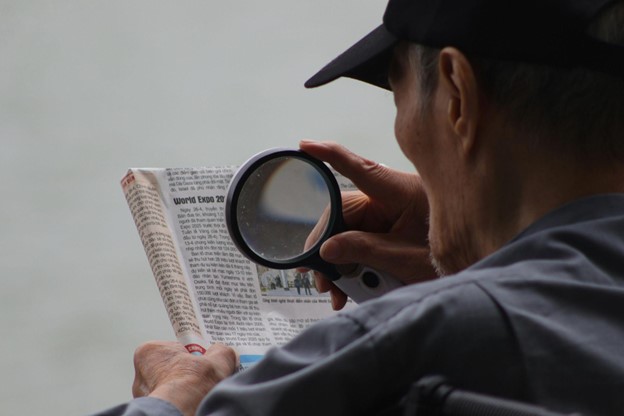
Aging and Eyesight: What Changes to Expect in Your 40s, 50s, and Beyond
Aging and eyesight go hand in hand. As the body changes with age, the eyes do too. Vision may not stay the same from decade to decade, and these changes are a normal part of aging.
From reading glasses in your 40s to increased dryness or light sensitivity later on, age-related vision changes can affect daily comfort and quality of life. The good news is that many of these issues are manageable with proper care, regular eye exams, and attention to long-term eye health.
How Aging Affects Vision Over Time
Understanding how aging affects vision begins with a look at what happens inside the eye as we grow older. The eye’s lens becomes less flexible, making it harder to focus up close. Tear production slows down, which can lead to dryness or irritation. Pupils shrink, reducing the eye’s ability to adjust to different lighting.
Some people also develop more sensitivity to glare and may notice a slower response to changes in light. Night driving becomes more difficult for many people as contrast sensitivity declines.
These changes may happen gradually, but they are common and expected as part of aging.
What Affects Turning 40 Has on Aging and Eyesight?
Vision changes after 40 often start with difficulty reading small print or focusing on nearby objects. This condition is called presbyopia, affecting nearly everyone at some point. It happens because the eye’s lens loses flexibility, making close-up vision harder.
Many people begin to rely on reading glasses, bifocals, or progressive lenses during this stage. Others may notice eye strain, especially after reading or working on a computer for extended periods.
Routine comprehensive eye exams become increasingly important after 40. They check for prescription changes and help detect early signs of glaucoma or macular degeneration, which may not immediately cause symptoms.
Maintaining Eye Health in Your 50s and Beyond
Eye health in your 50s often involves new adjustments. Dry eye becomes more common due to reduced tear production. Some people also report more floaters, small, shadowy shapes that drift across the visual field. While usually harmless, a sudden increase in floaters or flashes of light may indicate a more serious issue.
Night vision may also decline, and sensitivity to glare increases. Driving at night or adjusting to indoor lighting can become more difficult.
Early signs of cataracts, glaucoma, or macular changes may also begin to appear during this period. Protecting your eyes with UV-blocking sunglasses, managing blood sugar levels, and checking blood pressure all help reduce the effects of aging and eyesight.
Consistent yearly eye exams allow professionals to catch these developments early and recommend the proper steps to preserve vision.
Aging and Eyesight: Age-Related Eye Problems to Watch Out For
Several age-related eye problems become more common after 50. Some may develop slowly, while others require more urgent attention.
Cataracts
The eye’s lens becomes cloudy, leading to blurry or dim vision. Cataracts are common with age and can be corrected with surgery when vision becomes too impaired.
Age-Related Macular Degeneration (AMD)
This affects the macula, the part of the retina responsible for central vision. AMD may start with subtle blurring but can progress and impact reading, driving, and recognizing faces. Risk increases with age, smoking, and family history.
Glaucoma
This condition involves increased pressure in the eye, which can damage the optic nerve. Glaucoma often progresses without noticeable symptoms at first, which is why regular screenings are essential.
Diabetic Retinopathy
People with diabetes are at risk of damage to the retina’s blood vessels. Managing blood sugar, blood pressure, and cholesterol is vital to protect vision.
These conditions highlight the importance of regular eye checkups, especially as you move into your 50s and beyond. Early detection leads to better outcomes and helps preserve your eyesight.
Tips to Keep Your Vision Sharp as You Age
There are many steps you can take to support healthy eyes throughout adulthood. These practical habits make a lasting difference.
Eat Eye-Healthy Foods
Nutrition plays a key role in long-term eye health. Focus on foods rich in:
● Vitamin A: Carrots, sweet potatoes, dark leafy greens
● Lutein and Zeaxanthin: Spinach, kale, corn
● Omega-3 fatty acids: Salmon, flaxseeds, walnuts
These nutrients help reduce the risk of cataracts and macular degeneration.
Schedule Regular Eye Exams
A complete exam every 1–2 years can detect problems early. Don’t wait until symptoms appear.
Use Sunglasses
UV protection isn’t just for comfort. Prolonged exposure to sunlight can increase the risk of cataracts and macular damage.
Take Screen Breaks
If you use digital devices often, follow the 20-20-20 rule: every 20 minutes, look at something 20 feet away for 20 seconds.
Manage Health Conditions
Keep diabetes, hypertension, and high cholesterol under control. These conditions directly impact the blood vessels in your eyes.
Good habits stack up over time and can help protect your vision well into your later years.
Be Proactive About Vision Changes
Aging and eyesight are closely connected, but age-related eye problems don’t have to catch you off guard. Staying informed, attending regular eye exams, and adopting daily habits that support eye health will help you maintain clear, comfortable vision for years to come.
Your eyes work hard every day; give them the attention they deserve.
Take Charge of Your Eye Health Today
You don’t need to wait for vision problems before paying attention to your eyes. Start by scheduling your next comprehensive eye exam, making small daily changes to support your sight, and learning about age-related vision care.
Explore trusted guidance, resources, and support atHealthy Vision Association, because seeing clearly at every age starts with the steps you take today.
